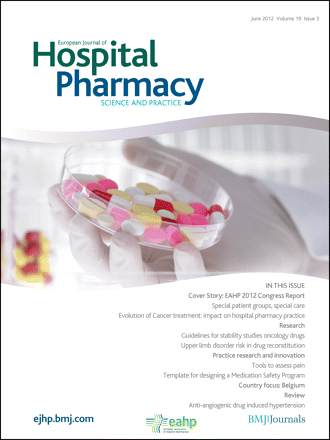EAHP EU Monitor 24 August 2012
The EAHP EU Monitor is a weekly round up of news relevant to hospital pharmacy in Europe.
You can subscribe to receive the EAHP EU Monitor by email here.
|
|
EAHP responds to Commission consultation on Citizen Rights
The European Association of Hospital Pharmacists has responded to a European Commission consultation on Citizens Rights calling for barriers to qualification recognition to be removed. The subject of the consultation is “Your rights, your future” and focuses on exploring individual experiences in 3 particular areas:
EAHP’s response focused on the first of these three areas, outlining the difficulties many hospital pharmacists can experience in having their qualification recognised in another country. EAHP is advocating reforms to the Directive on the Mutual Recognition of Professional Qualifications (2005/36) that could address this problem by allowing post-graduate specialisations of the 7 automatically recognised professions (including pharmacy) to be recognised on the basis of agreed competence frameworks, instead of a strict duration-based approach. Although the Commission have so far been unwilling to make such changes, EAHP is now working closely with both the European Union of Medical Specialists (UEMS) and the European Board of Veterinary Specialisation (EVBS) to explore opportunities for joint approaches on these issues. Hospital Pharmacists from across Europe are encouraged to respond to the consultation giving examples of any difficulties they have experienced in having their hospital pharmacy qualification recognised. Relevant questions in the consultation to this issue are questions 3, 4, and 9. Hospital Pharmacists should be aware the consultation closes on 9 September 2012. If you would like any background or information on EAHP’s response please contact the EAHP Policy and Advocacy Officer Richard Price by email po[at]eahp[dot]eu More information here. |
 |
Gap between agreed and actual working time across the EU remains wide
The actual working week for full time workers stood at 39.7 hours across the 27 EU Member States in 2011, an average of 1.6 hours more than the agreed working hours, according to Eurofound's latest annual update of working time developments. Eurofound's annual update on working time developments looks at the time spent at work across all Member States of the European Union and Norway.Collective agreements set the working time conditions for an average of 3/4 of all workers across the EU, with large differences between countries. Across the 27 EU Member States, full-time employees in Romania worked the longest weekly hours in 2011 – 41.3 hours, the same as in 2010. They were followed by employees in Luxembourg (40.7), Germany (40.6), Estonia and the UK (both 40.5), Austria and Bulgaria (both 40.3), and the Czech Republic and Poland (both 40.2). Employees in Finland worked the shortest hours (37.8). This was 3.5 hours less than their counterparts in Romania or 4.5 weeks of work in Romania in a full year. The report is available at http://bit.ly/WTupd12 Meanwhile, following proposals from social partners, the European Commission has decided to extend negotiations over changes to the Working Time Directive to the end of 2012. In 2010, the Commission began a consultation process with relevant social organisations representing management and labour, including the European Trade Union Confederation (ETUC). With negotiations on-going, the Commission has said it will not put forward proposals until the negotiations conclude. In general, EAHP understands that there appears to be little desire amongst the negotiating parties for a completely reworked Directive. Rather discussions are in favour of a reworking around prominent European Court of Justice cases (e.g. SiMAP, Jaeger) dealing with the definition of working time and the timing of compensatory rest. More information here. |
|
|
EJHP: Effectiveness and Safety Of Sodium Oxybate In Narcolepsy-Cataplexy Syndrome
An original research article on the safety and efficacy of Sodium OxybateIn Narcolepsy-Cataplexy Syndrome has recently been published on the website of the European Journal of Hospital Pharmacy. A retrospective study was conducted in all adult patients diagnosed with narcolepsy-cataplexy syndrome and treated with sodium oxybate in a tertiary hospital during a 4-year period by reviewing medical records, pharmaceutical follow-up and physicians' reports. All patients showed a major reduction in the number of seizures per week at an effective dose of 6–9 g, from a mean of 8.19 before treatment to a mean of 2.32 after treatment, although the significance was only borderline due to the small sample size. Remaining symptoms were also successfully controlled by the treatment. Adverse effects included nausea, dizziness, headaches, anxiety and depression. The study concluded that sodium oxybate in doses of 6–9 g/night can be considered an effective and safe drug for the treatment of adult patients with narcolepsy-cataplexy syndrome. More information here. |






